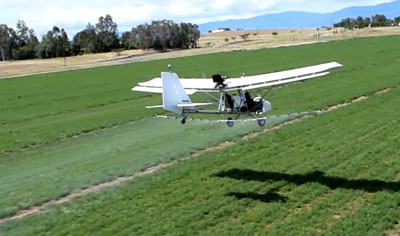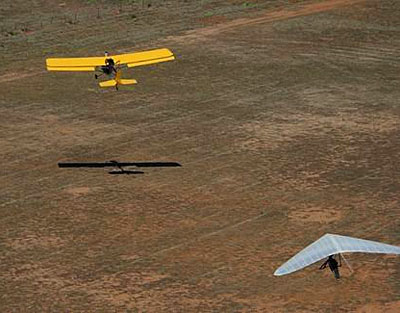
You may not know this Dragonfly airplane but I do. Very well. Since before it was called Dragonfly, I followed the development of this unusual aircraft by Bobby Bailey. You probably don’t know him either but he’s one of the most inventive light aircraft designers. A man of very few words, he prefers to create than to talk about it. Dragonfly is an important icon in the hang gliding community. This aircraft was purpose-built to tow hang gliders aloft. At a place near Sun ‘n Fun called Wallaby Ranch, this happens nearly every day of the year. Proprietor Malcolm Jones founded “the Ranch” in 1992. He has a fleet of Dragonflys that he uses to tow up experts, students learning to fly, or almost anyone wanting to get an introduction to hang gliding. Dragonfly has been fantastically productive, towing so many thousands of flights that I doubt they could be accurately counted.



 Some Dragonfly pilots working at the Ranch have more than 10,000 hours logged in Dragonflys alone. All that is achieved in an intense, full-power flight towing a hang gliding on a 200 or so foot line to 2,500 feet then releasing the glider, abruptly powering back to idle thrust, and diving madly for the ground to snatch another waiting pilot into the air. A round-trip takes literally minutes so think about how many takeoffs and landings were involved for a pilot to log 10,000 hours doing so.
During some competition events, I have seen 11 Dragonflys doing this drill. It is nearly mind-blowing to watch a collection of these awkward-looking aerial tractors whizzing this way and that in an utterly chaotic-looking yet amazingly well-choreographed ballet of tow planes and glider pilots. You literally have to see it to belief it. My words to describe it pale in comparison.
Some Dragonfly pilots working at the Ranch have more than 10,000 hours logged in Dragonflys alone. All that is achieved in an intense, full-power flight towing a hang gliding on a 200 or so foot line to 2,500 feet then releasing the glider, abruptly powering back to idle thrust, and diving madly for the ground to snatch another waiting pilot into the air. A round-trip takes literally minutes so think about how many takeoffs and landings were involved for a pilot to log 10,000 hours doing so.
During some competition events, I have seen 11 Dragonflys doing this drill. It is nearly mind-blowing to watch a collection of these awkward-looking aerial tractors whizzing this way and that in an utterly chaotic-looking yet amazingly well-choreographed ballet of tow planes and glider pilots. You literally have to see it to belief it. My words to describe it pale in comparison.
 Every U.S. state is different when it comes to aerial application, said Ed. "Here in California, a land owner is allowed to spray their own property from the air with a standard Applicators Permit. Dragonfly Rancher is a bonafide piece of farm and ranch equipment."
"Vne on Dragonfly was 66 mph (upped from those earlier models) and Rancher goes further, to 88 mph Vne." The newly beefed-up Dragonfly can carry enough payload to do micro spraying, which — if you don't know as I did not — is a legitimate method of application in some situations.
"We increased the gross weight to 1,200 pounds because we will be putting it on floats, also," said Ed. "Bobby re-schemed the wings, which only gained 2.2 pounds each to get to that higher gross weight." The all-up weight went from 992 pounds (450 kg) earlier.
Every U.S. state is different when it comes to aerial application, said Ed. "Here in California, a land owner is allowed to spray their own property from the air with a standard Applicators Permit. Dragonfly Rancher is a bonafide piece of farm and ranch equipment."
"Vne on Dragonfly was 66 mph (upped from those earlier models) and Rancher goes further, to 88 mph Vne." The newly beefed-up Dragonfly can carry enough payload to do micro spraying, which — if you don't know as I did not — is a legitimate method of application in some situations.
"We increased the gross weight to 1,200 pounds because we will be putting it on floats, also," said Ed. "Bobby re-schemed the wings, which only gained 2.2 pounds each to get to that higher gross weight." The all-up weight went from 992 pounds (450 kg) earlier.
 I asked Ed to explain what they did to bump gross and Vne speed. "We reduced rudder pressure, added electric flaperons, reinforced the main gear, and improved longitudinal stability of the Dragonfly," he clarified. A nose cone and windscreen reduces fatigue for a working pilot. Yet Dragonfly remains "fun to fly," he asured. "It actually performs better with flaps up in aerobatics — spins and loops — and still does a controllable spin."
"With floats it can be used for Introductory Flights as a SLSA," added Ed. Training pilots for towing required a second seat, though it is commonly, and easily, removed along with the aft joystick and pedals.
Interested in micro spraying? "My website has tax calculator link to see federal tax benefits," reported Ed. (calculator is another website) Also some videos.
Get more info on this hard-working aircraft on
I asked Ed to explain what they did to bump gross and Vne speed. "We reduced rudder pressure, added electric flaperons, reinforced the main gear, and improved longitudinal stability of the Dragonfly," he clarified. A nose cone and windscreen reduces fatigue for a working pilot. Yet Dragonfly remains "fun to fly," he asured. "It actually performs better with flaps up in aerobatics — spins and loops — and still does a controllable spin."
"With floats it can be used for Introductory Flights as a SLSA," added Ed. Training pilots for towing required a second seat, though it is commonly, and easily, removed along with the aft joystick and pedals.
Interested in micro spraying? "My website has tax calculator link to see federal tax benefits," reported Ed. (calculator is another website) Also some videos.
Get more info on this hard-working aircraft on